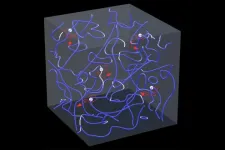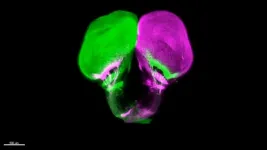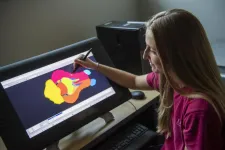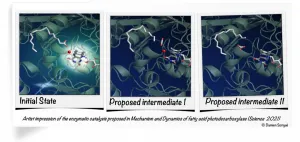(Press-News.org) Nobel laureate in physics Richard Feynman once described turbulence as "the most important unsolved problem of classical physics."
Understanding turbulence in classical fluids like water and air is difficult partly because of the challenge in identifying the vortices swirling within those fluids. Locating vortex tubes and tracking their motion could greatly simplify the modeling of turbulence.
But that challenge is easier in quantum fluids, which exist at low enough temperatures that quantum mechanics -- which deals with physics on the scale of atoms or subatomic particles -- govern their behavior.
In a new study published in Proceedings of the National Academy of Sciences, Florida State University researchers managed to visualize the vortex tubes in a quantum fluid, findings that could help researchers better understand turbulence in quantum fluids and beyond.
From left, Wei Guo, an associate professor of mechanical engineering at the FAMU-FSU College of Engineering, and Yuan Tang, a postdoctoral researcher at the National High Magnetic Field Laboratory, in front of the experimental setup. (Courtesy of Wei Guo)
"Our study is important not only because it broadens our understanding of turbulence in general, but also because it could benefit the studies of various physical systems that also involve vortex tubes, such as superconductors and even neutron stars," said Wei Guo, an associate professor of mechanical engineering at the FAMU-FSU College of Engineering and the study's principal investigator.
The research team studied superfluid helium-4, a quantum fluid that exists at extremely low temperatures and can flow forever down a narrow space without apparent friction.
Guo's team examined tracer particles trapped in the vortices and observed for the first time that as vortex tubes appeared, they moved in a random pattern and, on average, rapidly moved away from their starting point. The displacement of these trapped tracers appeared to increase with time much faster than that in regular molecular diffusion -- a process known as superdiffusion.
Analyzing what happened led them to uncover how the vortex velocities changed over time, which is important information for statistical modeling of quantum-fluid turbulence.
"Superdiffusion has been observed in many systems such as the cellular transport in biological systems and the search patterns of human hunter-gatherers," Guo said. "An established explanation of superdiffusion for things moving randomly is that they occasionally have exceptionally long displacements, which are known as Lévy flights."
But after analyzing their data, Guo's team concluded that the superdiffusion of the tracers in their experiment was not actually caused by Lévy flights. Something else was happening.
"We finally figured out that the superdiffusion we observed was caused by the relationship between the vortex velocities at different times," said Yuan Tang, a postdoctoral researcher at the National High Magnetic Field Laboratory and a paper author. "The motion of every vortex segment initially appeared to be random, but actually, the velocity of a segment at one time was positively correlated to its velocity at the next time instance. This observation has allowed us to uncover some hidden generic statistical properties of a chaotic random vortex tangle, which could be useful in multiple branches of physics."
Unlike in classical fluids, vortex tubes in superfluid helium-4 are stable and well-defined objects.
"They are essentially tiny tornadoes swirling in a chaotic storm but with extremely thin hollow cores," Tang said. "You can't see them with the naked eye, not even with the strongest microscope."
"To solve this, we conducted our experiments in the cryogenics lab, where we added tracer particles in helium to visualize them," added Shiran Bao, a postdoctoral researcher at the National High Magnetic Field Laboratory and a paper author.
The researchers injected a mixture of deuterium gas and helium gas into the cold superfluid helium. Upon injection, the deuterium gas solidified and formed tiny ice particles, which the researchers used as the tracers in the fluid.
"Just like tornadoes in air can suck in nearby leaves, our tracers can also get trapped on the vortex tubes in helium when they are close to the tubes," Guo said.
This visualization technique is not new and has been used by scientists in research labs worldwide, but the breakthrough these researchers made was to develop a new algorithm that allowed them to distinguish the tracers trapped on vortices from those that were not trapped.
INFORMATION:
Their research was supported by the National Science Foundation and the U.S. Department of Energy. The experiment was conducted at the National High Magnetic Field Laboratory at Florida State University.
The network of nerves connecting our eyes to our brains is sophisticated and researchers have now shown that it evolved much earlier than previously thought, thanks to an unexpected source: the gar fish.
Michigan State University's Ingo Braasch has helped an international research team show that this connection scheme was already present in ancient fish at least 450 million years ago. That makes it about 100 million years older than previously believed.
"It's the first time for me that one of our publications literally changes the textbook that I am teaching with," said Braasch, as assistant professor in the Department of Integrative Biology in the College ...
URBANA, Ill. - When scientists need to understand the effects of new infant formula ingredients on brain development, it's rarely possible for them to carry out initial safety studies with human subjects. After all, few parents are willing to hand over their newborns to test unproven ingredients.
Enter the domestic pig. Its brain and gut development are strikingly similar to human infants - much more so than traditional lab animals, rats and mice. And, like infants, young pigs can be scanned using clinically available equipment, including non-invasive magnetic resonance imaging, or MRI. That means researchers can test nutritional interventions in pigs, look at their effects on the developing brain via MRI, and make educated predictions about how those ...
Modern human-like brains evolved comparatively late in the genus Homo and long after the earliest humans first dispersed from Africa, according to a new study. By analyzing the impressions left behind by the ancient brains that once sat inside now fossilized skulls, the authors discovered that the brains of the earliest Homo retained a primitive, great ape-like organization of the frontal lobe. The findings challenge the long-standing assumption that human-like brain organization is a hallmark of early Homo and suggest that the evolutionary history of the human brain is more complex than previously thought. Our modern brains are larger and structurally different than those of our closest living relatives, ...
Researchers present a new, low-temperature method for injection-molding transparent fused silica glass, similar to how many plastic objects are manufactured. According to the authors, the process offers the possibility of producing complex and high-quality glass components using the same fabrication methods that allowed polymers to become one of the most important materials of the 21st century. The optical, thermal, mechanical and chemical properties of silicate glasses make them an ideal non-carbon based, high-performance material with applications ranging from packaging and architecture to high-throughput fiber optic ...
Using a novel genetic editing system termed intMEMOIR, researchers reveal the cell lineage histories of individual cells within their native tissue context, according to a new study. The new approach provides a powerful new tool for recording cell lineage in diverse cellular systems. During multicellular development, a cell's spatial position and lineage play important roles in cell fate determination. The ability to visualize lineage relationships directly within their native tissues can provide valuable insight into the factors that affect development and disease. This promise has spurred the development of several ...
X-ray emissions from the Crab Pulsar are more intense during giant radio pulses (GRPs), researchers report. The new findings provide constraints on the mechanisms underlying GRPs and may provide insights into other transient radio phenomena observed throughout the Universe. Pulsars, or rapidly spinning neutron stars, emit pulses of electromagnetic radiation from their magnetospheres and are observed from Earth as regular sequences of radio pulses. Most radio pulses from these distant objects are of a consistent intensity. Occasionally, however, sporadic and short-lived ...
The functioning of the enzyme FAP, useful for producing biofuels and for green chemistry, has been decrypted. This result mobilized an international team of scientists, including many French researchers from the CEA, CNRS, Inserm, École Polytechnique, the universities of Grenoble Alpes, Paris-Saclay and Aix Marseille, as well as the European Synchrotron (ESRF) and synchrotron SOLEIL. The study is published in Science on April 09, 2021.
The researchers decrypted the operating mechanisms of FAP (Fatty Acid Photodecarboxylase), which is naturally present in microscopic algae such as Chlorella. The enzyme had been identified in 2017 as able to use light energy to form hydrocarbons from fatty acids ...
Two studies published in the open-access journal PLOS Pathogens provide new evidence supporting an important role for the immune system in shaping the evolution of SARS-CoV-2, the virus that causes COVID-19. These findings--and the novel technology behind them--improve understanding of how new SARS-CoV-2 strains arise, which could help guide treatment and vaccination efforts.
For the first study, Rachel Eguia of Fred Hutchinson Cancer Research Center in Seattle, Washington, and colleagues sought to better understand SARS-CoV-2 by investigating a closely related virus that has circulated widely for a far longer period of time: the common-cold virus ...
A group led by scientists from the RIKEN Cluster for Pioneering Research, using coordinated observations of the Crab pulsar in a number of frequencies, have discovered that the "giant radio pulses" which it emits include an increase in x-ray emissions in addition to the radio and visible light emissions that had been previously observed. This finding, published in Science, implies that these pulses are hundreds of times more energetic than previously believed and could provide insights into the mysterious phenomenon of "fast radio bursts (FRBs)."
Giant radio pulses--a phenomenon where extremely short, millisecond-duration pulses of radio waves are emitted--have ...
Researchers at the Francis Crick Institute have found that blocking a specific protein could increase tumour sensitivity to treatment with PARP inhibitors. Their work published in Science , suggests combining treatments could lead to improved therapy for patients with inheritable breast cancers.
Some cancers, including certain breast, ovarian and prostate tumours, are caused by a fault in the BRCA1 or BRCA2 genes, which are important for DNA repair. Treatment for these cancers has greatly improved thanks to the discovery of PARP inhibitors, drugs which capitalise on this weakness in the cancer ...




